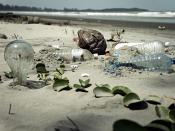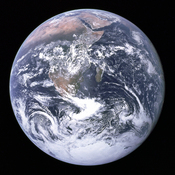Introduction:
Business as usual is not an option. The continuing degradation of our natural resources and the impoverishment of large segments of the world's population are placing our security, and that of future generations, at risk. To be more sustainable, development must improve economic efficiency, protect ecological systems, and enhance the well-being of all peoples.
Definition:
Sustainable development means different things to different people, but the most frequently quoted definition is from the report Our Common Future
"Sustainable development is development that meets the needs of the present without compromising the ability of future generations to meet their own needs."
Sustainable development focuses on improving the quality of life for all of the Earth's citizens without increasing the use of natural resources beyond the capacity of the environment to supply them indefinitely. It requires an understanding that inaction has consequences and that we must find innovative ways to change institutional structures and influence individual behaviour.
It is about taking action, changing policy and practice at all levels, from the individual to the international.
Sustainable development is not a new idea. Many cultures over the course of human history have recognized the need for harmony between the environment, society and economy. What is new is an articulation of these ideas in the context of a global industrial and information society.
Critical Actions:
Around the world we see signs of severe stress on our interlocked global economic, environmental and social systems. Already we are faced with full-scale emergencies through freshwater shortages, tropical forest destruction, species extinction, urban air pollution, and climate change.
How do we quickly reverse these trends? Revive growth
Change the quality of growth
Meet essential needs and aspirations for jobs, food, energy, water and sanitation
Ensure a sustainable level of population
Conserve and enhance the resource base
Reorient technology and manage risk
Include and combine environment and economics considerations in decision-making
These recommendations are as valid today as they were when first written. They are a call to change our actions and to do things differently. In particular, they underscore a need to:
Produce differently - apply concepts of eco-efficiency and sustainable livelihoods
Consume differently
Organize ourselves differently - increase public participation while reducing corruption and perverse subsidies
When taken together, these actions can help orient us on a path toward sustainable development.
Produce Differently:
Increasing efficiency and reusing materials will play important roles in achieving sustainable development. Eco-efficient companies and industries must deliver competitively priced goods and services that improve peoples' quality of life, while reducing ecological impacts and resource-use intensity to a level within the Earth's carrying capacity.
- reducing the scale of polluting activities and creating new opportunities for entrepreneurs.
The new generation of small, medium and micro-enterprises that operate within a sustainable development framework will expand our understanding of appropriate technologies and their contribution to creating sustainable livelihoods. In developing countries, achieving sustainable development will require overall national income growth of around 5 to 6 per cent a year. For this to occur, however, without further degrading the environment and society, growth must be qualitatively different than in the past. Capital-intensive production systems may be unattainable and undesirable in many situations. Creating 12 million old-style industrial jobs in India, for example, would require an investment of four to six times that of its GNP. Alternative types of systems must be found that provide for high levels of productivity and meaningful work.
Equity and Fairness:
Sustainable development is concerned with meeting the needs of the poor and marginalized portions of our population.
Long-term View:
How long is long term? In Western society during the past generation, most official long-term planning has been at most three to five years. Many international stock and currency traders now think of a few weeks as long term. Traditional Native American governance, however, focused on planning for "the seventh generation today." Goals and activities are designed with consideration for their impact on seven generations into the future, leading to a planning horizon of roughly 150 years.
A planning horizon somewhere in the middle may be both necessary and realistic. Some experts have suggested that as long as each generation looks after the next--roughly 50 years--each succeeding generation will be taken care of. Of course, if an effect in the yet further future is foreseen, then it too can be taken into account. No generation can be expected to guarantee results it cannot foresee; but equally, none should be allowed to ignore those it can.
People from around the world are looking ahead and building scenarios about what the future may be like. The scenarios they envision range from a world of resource scarcity and violence to one of increased sharing and technological innovation. Which scenario is most likely to occur? No one is certain.
In an interdependent world, complex interactions are leading to a startlingly high rate of innovation and change. In times of rapid change, the precautionary principle can provide some guidance. It states that when an activity raises threats of harm to the environment or human health, precautionary measures should be taken even if some cause-and-effect relationships are not fully established scientifically.
Systems Thinking:
For some two centuries we have known that the Earth is a closed system with finite resources. As planetary explorers completed the task of mapping the lands and waters, people slowly grew to understand that there are no "new" resources. We have only one Earth. All of our activities are but a small part of this larger system. Viewing our human systems as operating within the larger ecosystem is crucial for achieving a sustainable relationship with the environment, and assuring our own species' continued survival on the planet.
Each natural resource used by human beings--food, water, wood, iron, phosphorous, oil and hundreds of others--is limited by both its sources and its sinks. Resources should not be removed faster than they can be renewed nor disposed of more quickly than they can be absorbed. Although environmentalists used to be concerned primarily about running out of sources, today more people are concerned about running out of sinks. Global warming, the ozone hole, and conflicts over the international shipment of hazardous waste are all problems that have arisen from our attempts to dispose of resources faster than the environment can absorb them.
Systems thinking require us to understand that while there is only one Earth, it is composed of a multitude of subsystems all interacting with each other. A variety of models have been developed to explain the Earth's subsystems. When measuring our progress toward sustainable development, these models provide useful frameworks for choosing indicators. The differences between the models show the specific perspectives which groups bring to sustainable development and embody their differing values.
We have learned that the consequences of decisions made in one part of the world quickly affect us all.
Conclusion:
As we work toward sustainable development, we must strive not to lose sight of the big picture. All too often it is easy to get caught up in our own efforts, joys and frustrations, and lose sight of the broad community of people around the world working toward the same goals. Although early environmentalists recommended that we "think globally and act locally," sustainable development challenges us to think and act both globally and locally. In our complex, interdependent world, people working in different places and sectors may have the answers we seek or be able to lend a hand. The SD Gateway is the Sustainable Development Communication Network's way of linking you to the stories and experts that are tackling the same issues you face.
As our company is a manufacturer of "white goods", this means that it consumes and disposes of vast amounts of raw and finished materials. So its decision to follow or not the principles of sustainable development is a crucial one concern all the regions where are company corporate. In comparison to other industries like the IT sector it can be so that it's much more important to adopt sustainable development. As it has been shown before organisation like the UN and EU have created stricter legislations concerning the promotion of sustainable development as an issue of "corporate responsibility". As our company is concerned both about its long term progress and the protection of the environment and the society I would suggest that it should promote the concept of the sustainable development in the update the environmental strategy. Thus I would suggest the rapid change of all the industrial processes in order for it to be more economical efficient and environmental friendly.
On the other hand a company that will miss the opportunity to sacrifice its short term profitability in order to become more environmental friendly, in the medium term will be faced with the following problems:
New and more heavy legislations will oblige the company to change radically its policy this will give bad reputation to the company.
Other companies which will have already changed their principles and processes will operate much more efficiently and will have much more economic gains and higher profits.
The two above mentioned arguments prove the case in favour of an early adoption of sustainable development.


